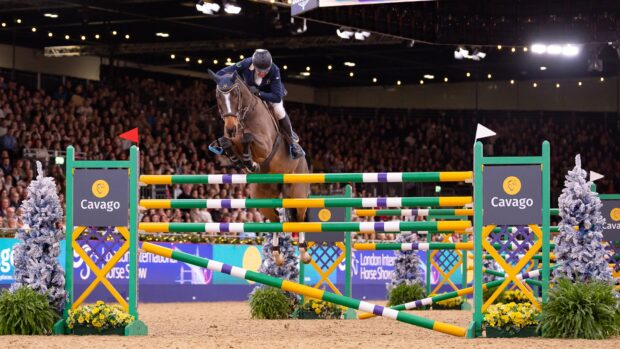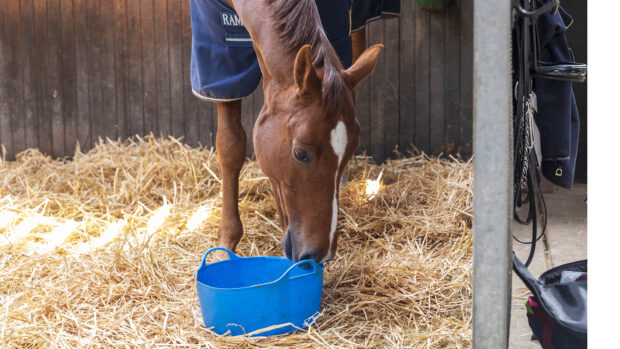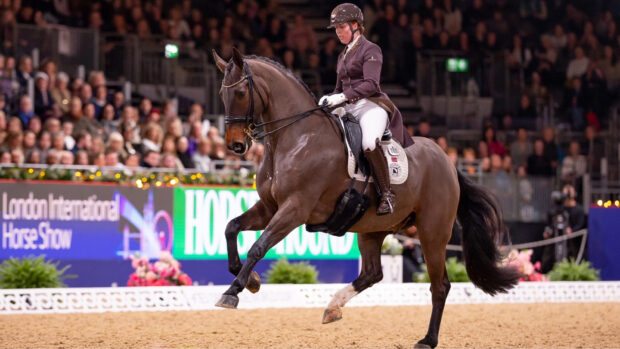Promotional feature with Champion
Susannah Stanning was competing at the Cotswold Team Chase in late October 2021 when she had a serious rotational fall. Her horse’s hindquarters came over and landed on the top of her head. She was knocked out for around 5mins and sustained a small skull fracture, but when Susannah saw pictures of her crushed Champion hat, she was amazed that she had survived at all.
“I was treated at the scene by a brilliant team before being taken to Gloucester hospital by ambulance,” says Susannah. “Later that evening, my groom sent the photos of my hat to me. And I was quite astounded to see the pictures. At that stage, I couldn’t really believe that I was there awake and alive, considering the fall that I’d suffered.”
When pictures of Susannah’s crushed hat were posted on social media, many people were shocked to see how misshapen it was, but the experts from Champion are keen to reassure riders that the hat had performed exactly as it should.
Champion brand manager Helen Riley explains: “It’s not widely understood how your helmet works to protect you in these circumstances, so the image of the hat may have looked shocking to the untrained eye. But we knew immediately that this hat had sustained a massive impact and had absorbed a large amount of energy.”
The nature of the fall meant that Susannah’s head did not remain fully inside the hat, which is part of the reason the hat suffered such deep depressions in some places, but also why her injuries were not more serious.
Helen continues: “The forces applied had actually squeezed Susannah’s head partly out of the hat, in the way that if you squeeze a tube of toothpaste, the paste is expelled from the tube. The flexible nature of the helmet’s harness fitting permits this to an extent to prevent further damage.”
* Warning* View graphic images of Susannah’s fall: picture 1, picture 2, picture 3 (credit: Paul Carley)
Riding hat construction
Some people are surprised that riding hats are designed to crumple rather than shatter when they sustain an impact, and that the harness is designed to expand when placed under sufficient load, but this is to ensure the extreme forces applied are dispersed.
“Like in cars, which have crumple zones rather than shatter zones, helmets are designed to crumple rather than shatter,” explains Helen. “This is because we make the materials of the helmet to absorb the energy. If you made a shell that shattered, it wouldn’t absorb the energy in the same way as a flexible shell would. This is why we make hats with the flexible materials to enable them to crumple so that they absorb the energy.”
Riding hats are made of three principal components: the outer shell, which is normally made of a rigid plastic or a composite material such as fibreglass; inside the shell is an expanded polystyrene liner; and the helmet is held on the rider’s head with the harness. The harness can be covered in suede or leather, but it will have a strong, synthetic webbing inside it.
Ben Hanna, production engineer at Champion says: “All these materials are designed to absorb energy under impact and under crushing events by being deformed. If these materials weren’t designed to crumple or move in any way, then all the force of the impact would be transmitted to the rider’s head. So by the very nature of these materials, we expect after an impact that the helmet should have been deformed in some manner.
“You can see from the pictures of Susannah’s fall that, due to the flexibility in the harness, the helmet is pinched up off her head slightly, which is where the huge dents come in because at that point, the skull is no longer present so there’s less resistance to that force, but all that damaging crushing absorbs a huge quantity of that energy and therefore protected her skull.”
So similar to a car that has been in a collision and has a damaged bumper, if a riding hat is worn in a serious fall, you shouldn’t expect a hat to come out looking perfect. That fact the hat is damaged means it’s done its job.
The forces involved
Having looked at the visual records of the accident, and with reference to academic studies, including one lead by Professor Michael Gilchrist in Ireland, who dropped horse cadavers onto the same sort instruments that are used in crash tests for cars to assess the forces involved, Ben believes Susannah’s head will have experienced a huge amount of force and energy.
Ben says: “We know from the nature of the fall and the kind of accident that Susannah had that her head would have sustained anywhere between 8,000 and 12,000 Newtons of force. To put that into context, that’s between 800 kilos and 1200 kilos – the equivalent of a mini resting on her head.
“We know from our internal testing that Champion hats will reduce that kind of transmitted force in the region of 70 to 80%. So although those are huge forces, the actual force that got through to her skull is relatively smaller. That’s why her injuries were just the small skull fractures as opposed to something more catastrophic. If you look at just the hat in isolation, you would have expected she would have had horrific injuries.”
Understanding hat standards
There are five main hat standards used across the world, each of which require hats to be tested for different performance requirements. All Champion helmets are designed to PAS 015 2011, while the Champion Pro-Ultimate is tested to Snell E2016.
“There are five main test criteria, which are crush, linear impact, penetration, harness strength and stability,’ explains Helen. “Some standards set performance requirements higher than others for each of those five test areas. A hat that is designed to PAS 015 standards has to withstand 800 Newtons of force, but a hat tested to the European VG1 standard would only have to withstand 630 Newtons. So there is quite a difference just between those two standards. Then the ASTM F116 315 standard doesn’t have any crash tests or penetration tests.
“The Snell standard gives you slightly more crush resistance as it is tested up to 1,000 Newtons, but the PAS 015 is absolutely brilliant for giving you all-round, excellent protection.”
It is important to note that price point doesn’t necessarily directly co-relate with safety when it comes to riding hats. The hat Susannah was wearing in her fall cost £90 from her local tack shop.
Helen concurs: “People believe that they’re getting safer hats if they spend humongous amounts of money, but that’s not always the case. With Champion, our lowest priced hat is just as safe as our highest priced one – they are all made to PAS 015 standard. So don’t be fooled into thinking that spending thousands of pounds on a hat means it’s much safer.”
When to replace your helmet
Susannah admits that in the world of team chasing riders can be a bit blasé about replacing their hats as they tend to fall off fairly frequently.
“For some people there might be the thought of ‘Oh, I’ve fallen off again. Do I really need to go and buy another hat?’,” she says. “But until I spoke to Ben, I couldn’t comprehend the damage that could be inside a hat that you can’t see and how much that liner might have been crushed in a few soft falls, which will compromise how much energy it can absorb if you have a really big fall.
“Please replace them regularly. I know they are expensive, but you only have one head; look after it, put the best helmet you can on top of it.”
And if you haven’t had a fall, then how frequently should you replace your riding hat?
Helen explains: “If you’re riding in your helmet every day, then we say you should be replacing your hat every 12 months, for occasional use from 12 months to three years, and for very, very light use you should be replacing it every three to five years.”



